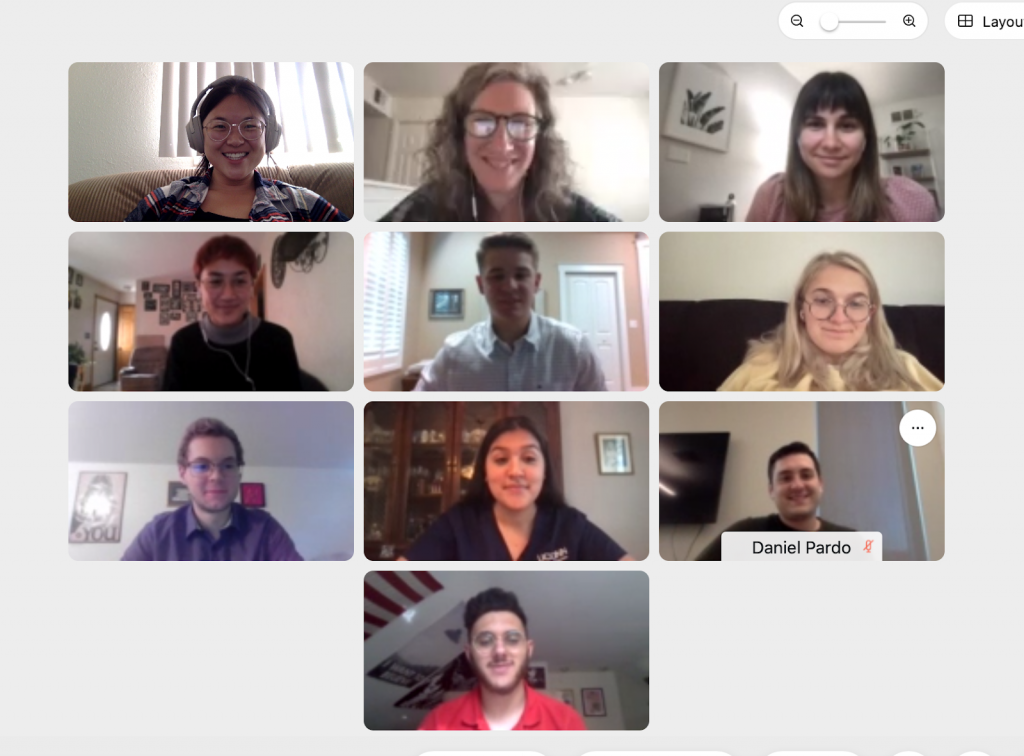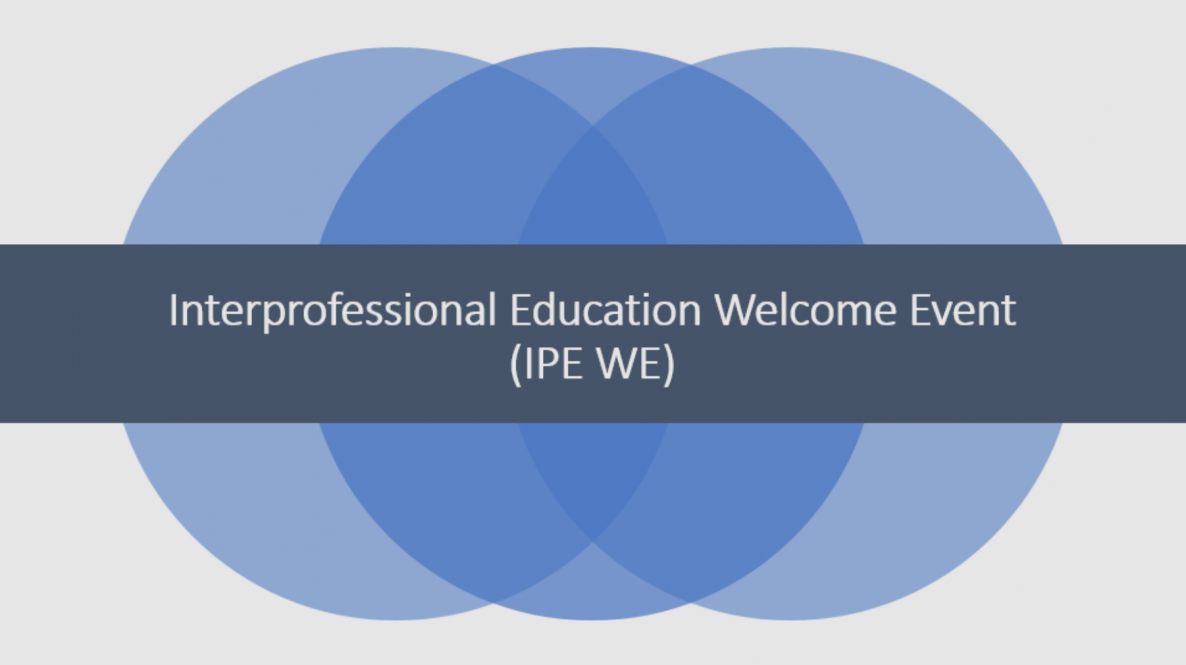I recently had the wonderful opportunity to participate in UConn’s annual university-wide Interprofessional Education Welcome Event (IPE WE) as a fourth-year pharmacy student panelist.
Almost 600 students and 70 faculty from 11 UConn Health professions programs participated in this 7th annual event planned by the University’s Committee on Interprofessional Excellence in Healthcare (CIPEH). UConn’s athletic training, audiology, clinical psychology, dental medicine, dietetics, medicine, nursing, pharmacy, physical therapy, speech language pathology, and social work programs participated.
The collaborative event introduces beginning health professional students to the concept of interprofessional education (IPE) and the importance of working alongside other members of the healthcare team to optimize patient outcomes. As a student who has participated in many IPE experiences since the beginning of pharmacy school, it was exciting to see how much these new health profession students learned from each other and the potential they have to grow in the next few years.

According to the World Health Organization, interprofessional education occurs when “students from two or more professions learn about, from and with each other to enable effective collaboration and improve health outcomes.” Dr. Devra Dang, Associate Clinical Professor in the School of Pharmacy, and a member of the planning committee for IPE WE elaborates, “It is very important for health professions students to start engaging in IPE early in their training. Learning how to work together as a cohesive interprofessional team as a student ensures that future clinicians will know how to engage in interprofessional collaborative practice (IPCP) when they are practicing clinicians. The ultimate goal of IPE and IPCP is improved patient care.”
“Interprofessional education is such an important concept in health profession training that it is a required component in the accreditation standards for all major health professions,” says Millicent Malcolm, Associate Clinical Professor in the School of Nursing and co-chair of CIPEH. “We designed IPE WE so that students who have never met each other have multiple opportunities to learn about, from, and with one another,” says Dr. Deborah Bubela, Associate Professor in the Department of Kinesiology.
Prior to the live events, students learned about the training and roles of other health professions through short videos and readings and interacted in small groups. Then, during the live session, they simulated caring for two complex patient scenarios as a team. Dr. Craig Denegar, Professor of Kinesiology and CIPEH co-chair, added, “We hope to ignite a career-long true understanding and propensity for team-based healthcare in all of our students so that they are capable of taking modern healthcare to the next level together.”
As a panelist this year, I had the opportunity to reflect back on my personal journey. Most of my IPE experiences came from Urban Service Track (UST) curriculum. During my second year of pharmacy school, I had the immense honor of being chosen as an UST Scholar.
In this unique curriculum, I learned alongside dental, medical, nursing, social work, and physician assistant students how to care for urban and underserved residents of Connecticut. We learned about each profession’s unique contribution to patient care and how the sum is greater than its parts in addressing health disparities and social determinants of health. I have also participated in many community outreach events that require many professions to work together, including health fairs, free clinics for migrant farm workers, and other service-learning opportunities.
One particularly memorable experience was interacting with doctor of audiology students at a health fair early last year. This was the first time that I learned about this profession and I was intrigued at their vast knowledge diagnosing and managing disorders of hearing, balance, and other neural systems. The audiology students even showed me how to use new hearing aid technology so I could help some of the older community members at the health fair. Similarly, the audiology students learned more about the pharmacy profession. Many didn’t realize that pharmacists’ training also requires a doctorate degree and includes all aspects of healthcare in addition to just pharmacotherapeutics. We discussed how pharmacists and audiologists can collaborate in caring for older patients with risk factors for falls. I’m grateful for IPE opportunities such as these because they allow me to learn about many different professions and how we can synergistically improve patient care.
Now, in my fourth and final year of the doctor of pharmacy program, I have been engaging in interprofessional teamwork first-hand as I learn to provide direct patient care within various healthcare settings. One recent clinical rotation took place in the surgical intensive care unit.
During rounds, I was able to see how important nurses are in monitoring patient symptoms and alerting the team, and how speech language pathologists and dietitians play a large role in determining the type of feeding that is safe for patients with swallowing difficulties. Similarly, I was able to make medication-related recommendations, such as the best time to draw labs to monitor for therapeutic drug serum concentrations or answering a medical resident’s questions about drug-induced side effects.
This month, I am on the Navajo Nation Reservation in New Mexico for my ambulatory care clinical rotation. Not surprisingly, interprofessional collaboration plays a major role here too. For example, recently a nurse practitioner was unsure about the differences between two meningitis vaccines: MenACWY and MenB. Together, we used the CDC’s immunization schedule to determine which vaccine the patient should receive based on age and risk factors.
My positive experiences with interprofessional education and collaboration so far are the reasons why I was so excited to participate in IPE WE. I loved observing the younger students grow and learn in such a short amount of time because I know this knowledge will carry with them into future career endeavors. This kind of event sparks the concept for many.
During the IPE WE session, the 500+ students were separated into 56 different virtual breakout rooms each with a faculty facilitator to discuss two patient cases. Afterwards, all the participants reconvened as a large group and listened to senior students give therapeutic recommendations about the patient cases from their profession’s perspective. I was selected to be the senior student discussing the role of pharmacists in the care of these patients. We ended the live session with students coming back into their small groups to discuss thoughts about this introduction to their IPE journey.
I was able to join one of the breakout groups and was thrilled to see that my fellow students were just as excited about this interprofessional event as I was. Ana Ortiz, a third-year nursing student, commented that she learned much more about other professions’ perspectives, especially physical therapy because she has little experience in that area. Similarly, Brian Legato, a first- year dental student, added that he learns so many textbook-definitions of medical concepts in school, but was astonished at how much effort goes into continuing care after hospitalization and how speech language pathologists play a large role in patient care since he has not learned about this profession yet.
Morgan Sauvageau, a first-year student in the speech language pathology master’s degree program summed up the group’s sentiment when she stated that she has set a goal for herself to “take the opportunity to learn and ask questions to other professionals so [she] can expand [her] knowledge as much as possible and treat [her] patients to the best of [her] ability.”
IPE WE opens eyes and ears to the every growing world of interprofessional health care, and the lessons it taught will hopefully resonate with all these early-year health professions students throughout the rest of their time in training and as a healthcare professional, just like it has for me.



